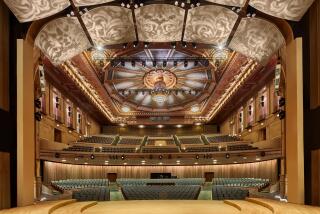JAZZ / DIRK SUTRO : Sax Man’s Satisfaction Dawns After 30 Years
- Share via
How long does it take to master the tenor sax? Joe Marillo has seen the Wanna-be’s come and go, signing up for lessons with visions of blowing like Coltrane overnight. When they find out the kind of dedication it takes, they generally drop out in a matter of months.
Unlike several of his ex-students, though, Marillo, 50, has continued his music for almost 30 years, and only recently has he begun to feel satisfied with his work, especially his improvisations.
“I just recorded us a few weeks ago at Croce’s, and I was thrilled,” he said. “This was the first time where I listened to the playback, and I said, ‘Finally, I’m making sense.’ It’s the melodic line which has always been the hardest thing for me. I’ve always been scattered, and I wasn’t one to sit down for hours and figure it out. I’ve always liked my feeling and expression, but never my melodic line.”
Marillo attributes the melodic breakthroughs in part to his second career the past six months as a cocktail-hour pianist at Vic’s in La Jolla. The piano work has helped him hear fresh possibilities for the sax, he said. Another factor has been the presence of his brother, Tony, on drums for several of the recent Croce’s dates.
“We have a certain musical rapport,” Marillo said. “I’ve never had a real commitment with a drummer.” Marillo’s current band also includes Steve Smith on bass and Forrest Westbrook on piano.
Marillo was born in Niagara Falls, N.Y. He studied at Berklee School of Music and Granoff School of Music (John Coltrane’s alma mater) before heading west. He worked with show bands in Las Vegas before moving to San Diego in 1972, where he was one of the first to book major jazz talent here, luring names like Stan Getz, Woody Herman, Carmen McRae and Sarah Vaughan to the Catamaran. He also played behind them.
As a teacher, Marillo has taught a whole new generation of San Diego sax talents including Tripp Sprague, Steve Feierabend and Mark Lessman.
Now that his sound satisfies him, he’s eager to replace his casual self-made recordings with serious ones. He hopes to do a high-quality live session, possibly at Croce’s, where you can hear him Saturday evenings and leading the Sunday night jam sessions through the month of June.
San Diegans sometimes overlook the stature of our local jazz talent. A reminder is visible in the new issue of Downbeat, the jazz magazine, which gives a 4 1/2-star rating (out of five) to San Diego pianist Mike Wofford’s new album on the Discovery label, a tribute to composer-arranger Gerald Wilson. “Wofford . . . is solid in his comping and subdued in his soloing,” reviewer Fred Bouchard writes. “Wofford brings subtle, new harmonic extensions to Wilson’s compositions with cohesive swing and energy.”
Local drummer Jim Plank is best known for his work in jazz, which he plays in a variety of settings, including the house rhythm section at Elario’s, where he usually joins Wofford and San Diego bass player Bob Magnusson. But Plank is a double agent: he has also signed to a 37-week contract with the San Diego Symphony, handling percussion duties ranging from snare drum and cymbals to tympany. On some evenings during symphony season, he finishes his classical duties, then races to Elario’s in time to play the last set or two. Plank is one of several musicians doing both San Diego Symphony work and jazz: others include bassists Don Hermanns and Jon Green, both session players based in Los Angeles.
Plank, Magnusson and San Diego pianist Randy Porter have been tapped to back jazz singer Diane Schuur at her Humphrey’s gig in August. San Diego sax player Benny Hollman and several members of his big band are also doing dates during Humphrey’s summer concert series. They recently backed the Four Tops and the Temptations, and are slated to appear with Little Anthony on July 30, Lou Rawls on Aug. 9, and, if her canceled date is re-scheduled, singer Natalie Cole.
San Diegans suddenly seem surprised to find a minimum expenditure required at Elario’s, the La Jolla jazz club. A recent letter to the Jazz Link, the local jazz paper, expresses one jazz fan’s dismay at the cost. But Steve Satkowski, who books the talent at the club, said the minimum is nothing new. It has always ranged from $5 to $10 per set for drinks or food. And, he points out, Elario’s still looks like a steal compared to clubs like the Blue Note in New York City, with its $10 minimum--plus a cover charge of $5 to $25. Humphrey’s is getting $20 for tickets to its summer concert series, which includes jazz players such as Schuur, guitarists Lee Ritenour and Earl Klugh, saxophonist Grover Washington Jr. and the brothers Ronnie and Hubert Laws. But, with Humphrey’s focusing on light, so-called “contemporary” jazz, Elario’s is still the only local venue offering a steady diet of top-notch straight-ahead jazz.
SHORT RIFFS: The live “Club Date” series, jazz shows taped by San Diego public television station KPBS in collaboration with Elario’s, are being marketed in Europe by CS Associates, based in Mill Valley, Calif. . . . Guitarist Joe Pass, who had balked at doing one of the shows because he wanted rights to the video, has agreed to a July 10 “Club Date” taping, with KPBS retaining all rights. . . . San Diego is increasing its stock of internationally known jazz talents. Sax player James Moody recently got married and moved to San Diego. Pass and pianist Kenny Barron have also been house-shopping here. . . . Trumpeter Miles Davis celebrates his 63rd birthday today. KSDS-FM (88.3) is playing his music in chronological order all day and giving away a copy of his new album, “Amandla,” on the air every hour.


